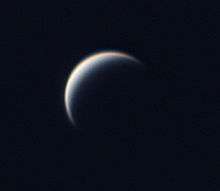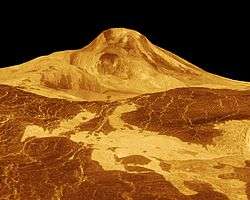Venera-D
|
The Venera-D spacecraft approaching clouds-veiled Venus | |
| Mission type | Interplanetary |
|---|---|
| Operator | Russian Federal Space Agency |
| Start of mission | |
| Launch date | 2025 (proposed)[1] |
| Rocket | Proton or Angara rocket |
| Venus orbiter | |
| Spacecraft component | Orbiter |
| Venus lander | |
| Spacecraft component | Lander |
The Venera-D (Russian: Венера-Д, pronounced [vʲɪˈnʲɛrə ˈdɛ]) probe is a proposed Russian space probe to Venus, to be launched around 2025.[1][2] Venera-D's prime purpose is to make radar remote-sensing observations around the planet Venus in a manner similar to that of the Venera 15 and Venera 16 probes in the 1980s or the U.S. Magellan in the 1990s, but with the use of more-powerful radar. Venera-D is also intended to map future landing sites. A lander, based on the Venera design, is also planned, capable of surviving for a long duration on the planet's surface.
Venera-D will be the first Venus probe launched by the Russian Federation (the earlier Venera probes were launched by the former Soviet Union). Venera-D will serve as the flagship for a new generation of Russian-built Venus probes, culminating with a lander capable of withstanding the harsh Venerian environment for more than the 1½ hours logged by the Soviet probes. Venera-D will most likely be launched on the Proton booster, but may be designed to be launched on the more powerful Angara rocket instead.
History
In 2003, Venera-D was proposed to the Russian Academy of Sciences for its "wish list" of scientific projects to be included into the Federal Space Program in 2006–2015. During the formulation of the mission concept in 2004, the launch of Venera-D was expected in 2013 and its landing on the surface of Venus in 2014.[3] In its original conception, it had a large orbiter, sub-satellite, two balloons, two small landers, and a large, long-lived lander. By 2011, the mission had been pushed back to 2018, and scaled back to an orbiter with a subsatellite orbiter, and a single lander with an expected 3 hour lifetime.[4] By the beginning of 2011, the Venera-D project entered Phase A (Preliminary Design) stage of development. Following the loss of the Phobos-Grunt spacecraft in November 2011 and resulting delays in all Russian planetary projects (with the exception of ExoMars, a joint effort with the European Space Agency), the implementation of the project was again delayed to no later than 2025.[1]
References
- 1 2 3 Foust, Jeff (16 November 2015). "Ben Carson's Prescription for Space Exploration". Space News. Retrieved 2015-12-07.
- ↑ "РАН: запуск "Венеры-Д" состоится не ранее 2024 года". Gazieta.ru. 9 April 2012. Retrieved September 26, 2013.
- ↑ Venera-D mission at Russia Space Web (accessed 25 November 2013)
- ↑ Ted Stryk, Russia's Venera-D mission (DPS-EPSC 2011), Planetary Society, 10/05/2011 (accessed 25 November 2013)




